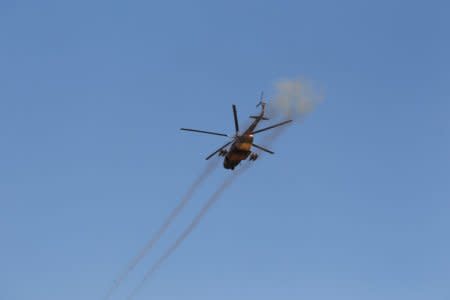Use of air power in Afghanistan up sharply as Trump troop decision looms

Thomson Reuters
By Josh Smith
KABUL (Reuters) - U.S. warplanes dropped more weapons on Afghanistan in April than in any other single month since 2012, according to new statistics, as military officials press U.S. President Donald Trump to send thousands more troops to the country.
The escalation in the use of American air power was partly due to an effort by U.S. commanders to wipe out a nascent Islamic State presence before the group can establish more of a foothold in the county, a military spokesman said.
The U.S. Air Force unleashed 460 bombs, missiles, or other ordnance last month in Afghanistan, more than double the 203 weapons dropped in March and more than seven times the quantity deployed in April last year.
Trump has yet to announce a decision on proposals from his top military advisers calling for the United States and its coalition allies to send 3,000 to 5,000 more troops to Afghanistan. Currently around 8,400 U.S. and 6,500 coalition troops are deployed, mostly to train and support Afghan forces.
The additional troops could also be used to ramp-up air support, which has often been seen as decisive in preventing the total collapse of some Afghan defensive positions and relies on trained air controllers on the ground.
The last time more weapons were dropped in a single month was August 2012, when nearly 80,000 U.S. troops were battling the Taliban and two years before former President Barack Obama declared an end to the combat mission in Afghanistan.
Since then, however, Afghan forces have struggled to hold back a resurgent Taliban insurgency. Islamic State's small local affiliate, sometimes known as Islamic State Khorasan (ISIS-K), has been active since 2015.
Last month the U.S. military dropped one of its largest conventional weapons ever used in combat, a 21,600-lb (9,797 kg) GBU-43 Massive Ordnance Air Blast bomb, on suspected Islamic State militants in eastern Afghanistan.
The Air Force data, however, shows that while unusually large, that bomb was only part of a greatly expanded air campaign.
As of the end of April, Air Force warplanes had released 917 weapons, compared with 1,337 in all of 2016, and 947 in 2015, the first year of the "non-combat" mission in Afghanistan.
For graphic, click: http://tmsnrt.rs/2qPjsUT
SPRING FIGHTING SEASON
U.S. military spokesman Captain Bill Salvin said the increase was due to greater latitude to provide air support to Afghan forces granted to military commanders by Obama last June, and the focus by General John Nicholson, who leads the foreign forces in Afghanistan, on going after Islamic state.
"The two main reasons are this is the first spring fighting season since the expanded authorities were granted," he said.
"And General Nicholson has stated the goal to eliminate ISIS-K in Afghanistan in 2017, which has required more offensive operations and strategic effects support."
The Air Force statistics only report "weapons released" as well as "sorties with at least one weapon release", neither of which necessarily correspond to a single air strike, which can include multiple weapons and aircraft.
The numbers also do not include strikes by the U.S. Army, which fields attack helicopters in Afghanistan, but Salvin told Reuters that, all together, U.S. forces had conducted 898 "kinetic strikes" in the first four months of the year, compared with less than 300 in the same period in 2016.
U.S. forces in Afghanistan are allowed to conduct air strikes under three circumstances, which include counter-terror operations, strikes to protect coalition forces, and air support that helps Afghan forces achieve "strategic effects" against Taliban or other insurgents.
Strikes in all three categories increased dramatically in April compared with a month before, Salvin said.
Ninety-two counterterrorism strikes were conducted in April, compared with 55 in March.
U.S. forces intervened with 296 strikes to provide "strategic effects" for Afghan forces in April, up from 115 the month before.
And U.S. aircraft were called upon 62 times to provide protection for coalition troops last month, a major increase from only six times in March.
Last month United Nations investigators reported a "substantial" and "disturbing" increase in casualties from air strikes by U.S. warplanes, as well as by the Afghan Air Force.
In the first quarter of 2017, 72 civilians were killed and 76 wounded in aerial operations by both U.S. and Afghan forces, up from eight dead and 21 injured in the corresponding period last year, the U.N. said.
(Writing by Josh Smith; Editing by Alex Richardson)
See Also:

 Yahoo News
Yahoo News 
